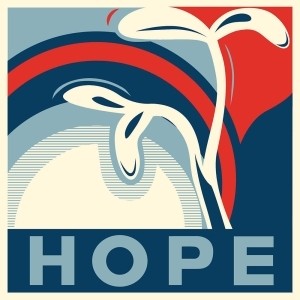Though I do not believe that a plant will spring up where no seed has been, I have great faith in a seed. Convince me that you have a seed there and I am prepared to expect wonders. —Henry David Thoreau
The pop singer Bono is fond of using the phrase “vision over visibility,” fond enough to consider it tattoo worthy. The phrase is a little abstract, I’ll grant you, but in essence he’s reduced the above Thoreau quote to a phrase that will fit on an arm. Hope requires imagination. It requires you to visualize what can be beyond the reality that’s right in front of your face.
We asked people in our tribe to tell us about hopeful things they see in their respective lines of work. Some of the answers are firmly ensconced in the here and now: from this vantage point, this is hopeful, this is good. Others reflect the vision over visibility theme. These folks find hope in the seeds of the future, in the idea that work being done today will blossom and flourish at a later time.
We’ve collected the responses to share with you. We then added two larger vignettes about dramatically successful land conservation initiatives and sprinkled in some stand-alone art pieces for good measure – the idea of hope funneled through a camera lens. Individually these sentiments and images can get lost in the din of adult life, but there’s strength in numbers here, like the power of birdsong on an early May morning. At the very least, we hope this feature provides a positive perspective as we exit the season of darkness and struggle and enter that of light and rebirth.—The Editors
Eric Johnson
This is not the first time loggers in the Northeast have looked out the cracked windshields of their pickups first thing in the morning and wondered whether or not they’re leaving a recession and entering a recovery or simply pausing for a breather on their final trip down the tubes. It’s a regular event, usually repeated every five to ten years. The fact that it’s become somewhat routine is small comfort to those forced to make some difficult decisions in the face of dangerous uncertainty. So what do loggers in the region have to be optimistic about, as they ponder their strategy for survival – and perhaps even success – in the coming year?
First off, the fact that they’re still in business after enduring a particularly crippling economic downturn – a time when most of their markets went “poof ” – speaks to their individual abilities and skills as business people. If there is indeed a future for the forest-products industry in this part of the world, these are the people you want running it.
Of course, there’s that big “if ” qualifying the last sentence. Possessing battle-hardened business skills doesn’t count for much if there’s no business to apply them to.
To have a business, you need markets. And to have markets, you need to have something people want to buy. Fortunately for loggers and landowners in the Northeast, Appalachian hardwoods are in high demand around the globe. They’ve always been in high demand, and probably always will be. People worldwide equate Appalachian hardwoods like oak, maple, cherry, and birch with quality and luxury. Those who can afford to – and there are still plenty of them around – will go with hardwoods every time. True, there are fewer loggers in business than there were two or three years ago. Those who remain will reap the rewards as the world economy continues to recover in 2011.
Eric Johnson is executive editor ofThe Northern Logger & Timber Processor magazine published in Old Forge, New York.
Esther Cowles
I see a lot of signs of hope in the environmental education field. Interest is mounting in strategies to connect young people to the natural world. National education associations for teachers and school administrators are dedicating their monthly journals to themes of inquiry, field investigations, the environment, and community. In New Hampshire, our Department of Education has invested (in deed and creed) in moving science from the classroom into the outdoors. Students respond enthusiastically, because any time they learn about how the natural world functions, it has meaning for them.
Returning the outdoors to the lives of our kids is becoming a pretty mainstream theme. Fifteen years ago, on the rare occasion that a media outlet discussed environmental education, it would have been framed as a controversial topic. Now, it is common to see or hear stories extolling the academic, physical, emotional, and psychological benefits of kids exploring the natural world around them.
On a personal level, my greatest hope comes when my 11- year-old daughter embraces our family’s naturalistic values. As a family, we favor unstructured time outdoors over electronics and organized sports in every season. This can be hard in our town of Type-A personalities. There is no recital or trophy for being a great bug-catcher. Instead, the rewards are intrinsic. But they are no less momentous. Just yesterday, my daughter implored that what she really wanted – much more than that ubiquitous Nintendo WII – was a small flock of chickens to raise all on her own. Now that is a sign of hope!
Esther Cowles is executive director of New Hampshire Project Learning Tree.
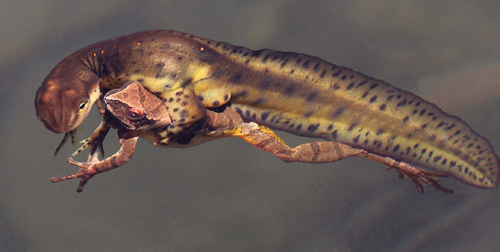
Roger A. Dziengeleski
As a forester, I’m eternally optimistic. I have the greatest job in the world – helping forests grow.
As another spring season approaches, I’m hopeful for a fundamental change in how society perceives and values America’s managed forests. I’m hopeful that more people from all walks of life will begin to understand that trees are the answer to so many of society’s needs and that responsibly managed forests are the solution to one of society’s leading environmental challenges – removing greenhouse gases from our air. I’m hopeful that our governments will forgo fee acquisition of working forests and prohibitions on timber harvesting in favor of conservation easements that keep forests as forests and allow those forests to be responsibly managed for products needed by society, such as lumber for shelter, paper for communication, and the variety of ecosystem services that managed forests offer.
I’m hopeful that our elected officials will make the necessary changes to our property tax and estate tax systems so that forest owners of all sizes can afford to keep their forests as forests rather than selling them for development.
I’m hopeful that more local governments will adopt planning and zoning policies that favor density over sprawl and, whenever possible, keep large contiguous forest tracts intact and in the business of wood and jobs production.
I’m hopeful that manufacturers and environmental organizations will continue to find ways to work together. An example of such a partnership is my employer, Finch Paper, partnering with The Nature Conservancy to provide jobs, products, and ecosystem services in New York’s Adirondack region.
Forests are the greatest and most versatile renewable resource we have, and it’s in all of our best interests to work together to keep forests as forests.
Roger A. Dziengeleski is vice president and chief forester of Finch Paper LLC in New York and president of the Society of American Foresters.
Jim Shallow
Emily Dickinson wrote: “Hope is the thing with feathers.” I was reminded of this recently, as I joined 60,000 other citizen scientists in the 111th Christmas Bird Count, which is the longest ongoing citizen science project in the world. This massive data set gives Audubon and our partners unparalleled information about the status of birds. Christmas Bird Count data were used to confirm the decline in bald eagles that was eventually linked to the use of DDT. Raptors – eagles, falcons, and osprey – were early indicators that we were poisoning the natural world we depend on. We stopped using DDT, placed the bald eagle on the endangered species list, and began the long work of restoring the population. In the last few years, Vermont joined all the other New England states and New York in hosting breeding pairs of eagles. The growing population of bald eagles is a tangible example of how we can turn things around when we use good data to focus on results.
A bird like the bald eagle is easy to rally behind. Lately, the data from the Christmas Bird Count and another citizen-science project, the Breeding Bird Survey, have documented that even common birds like the hermit thrush and the purple finch are declining at alarming rates. These birds and dozens of other species breed in our forests, making the Northeast a breeding hotspot for migratory birds. I remain hopeful because when we have shared this information with forest landowners and foresters, they have enthusiastically embraced their role in providing quality breeding habitat. Over the past four years, we have worked with more than 200 people, who collectively own over 120,000 acres, to implement forest management that will improve breeding conditions for birds and help the local forest-products economy. Their enthusiasm, like that of the birders who joined our Christmas Bird Count, convince me that hope is not just “the thing with feathers” but the collective passion and enthusiasm these individuals bring to the needs of birds – and by extension to our natural world.
Jim Shallow is the conservation and policy director with Audubon Vermont.
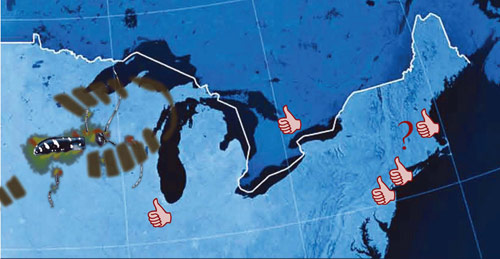
Sarah Smith
I find those working in the forest products industry to be the most pragmatic and adaptable people I know. They constantly adjust to changing conditions, scan the horizon for new ideas, try new approaches, and quickly change if something doesn’t work out. Oh, and did I say, work as hard as anyone on the planet?
I’ve experienced, by participating with the logger education programs and the New Hampshire Timber Harvesting Council, the development of a profession that sees the value in talking to and respecting each other. I see an emergence of the next generation – young men and women learning from their parents and using new technologies to become more efficient and communicating in new ways.
I see a higher logging standard in the woods, more bridges, less mud, better skills, and a safer work environment. I see, in the sawmills, amazing new technologies that push utilization to the outer limits and get more lumber from less log.
And I see truckers using incredible skill to negotiate the crumbling roads of New England to deliver the wood – the economic foundation that makes everything else happen.
Yes, I think we have a lot to be hopeful about.
Sarah Smith is a forest industry specialist with UNH Cooperative Extension.
Verandah Porche
“Hope” and “hop” may share a common root, as in “to leap, with expectation,” according to Eric Partridge, my favorite etymologist. All children own this connection. Hope shows the dance of meaning within language.
I was born with luck; poetry has been my beat and delight since childhood. For forty years, based on a farm in Vermont, I’ve made a living stringing words together. I have taught poetry in schools for a generation. As a poet-in-residence around New England, I search for unsung poems in our common air.
With toddlers and centenarians, I listen for the verse in conversation, for the moment talk turns, as cream clumps to butter in a churn. In nurseries, nursing homes, factories, hospitals, street corners, and kitchen tables, people tell me arias, soliloquies, stories to distill together. While I love writing poems for neighbors and strangers, the eloquence and wisdom of my narrators, “ordinary people with nothing to say,” continue to enrich my life.
For the 250th anniversary of my hometown, Guilford, Vermont, I gathered childhood and courtship stories from local elders into a play for voices, The Broad Brook Anthology. Alberta Whittemore Allen, narrator of this poem, grew up on what’s now the Guilford Fairgrounds.
The land stretched to the top of East Mountain.
I roamed every inch of it. When I was sad,
I used to go off by myself.
I loved the birds. I would lay under a tree
and watch what Nature was unfolding.
I was so still I became part of the landscape.
Out there I was a princess playing by the brook
with leaves flowing down for ships
I was sure there would be a prince sailing along
someday and eventually he did.
I’ve always had an angel on my shoulder.
I have no regrets.
Verandah Porche is a poet from Guilford, Vermont. More of her work can be seen at www.verandahporche.com.
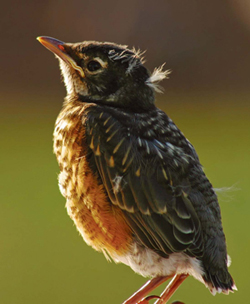
Dave Buxton
When I started New England Forest Products (NEFP) in 1993, there were 16 mills that sawed hardwood in New Hampshire. Today, there are two. Foreign market competition has taken a toll on the local wood-products business, as has the housing bust and the recession. The bigbox stores and many of the manufacturers often look for the cheapest source of lumber, cabinetry, furniture, and millwork without consideration for sustainability or origin of manufacturer. Fortunately, people are becoming much more aware of the importance of supporting local businesses.
Many of the remaining sawmills in the Northeast have adapted their business models to try to capitalize on a growing niche market for sustainably harvested local lumber products. At NEFP, we’ve added a dry kiln, millwork equipment, and a retail building to our existing processing infrastructure so that we can now market directly to the consumers. Nothing goes to waste here. Sawdust is sold to a local company that makes it into wood pellets; chips are sold for fuel used in chip-burning furnaces in area schools; cordwood is sold to homeowners; and the bark is ground in the spring and sold to landscapers and homeowners for landscaping mulch.
I find hope in the idea that people are becoming more conscious of the environment in their purchasing decisions. A renewed emphasis on buying local has the potential to save not just our working farms but our working forests as well.
The custom plank flooring a customer purchases from NEFP may very well have originated from their neighbor’s woodlot. If you consider the ripple effect here that runs from landowner to logger to millworker to consumer, it’s a very hopeful thing indeed.
Dave Buxton owns New England Forest Products in Greenfield, New Hampshire.
Jared Duval
Last year, I was looking through an old scrapbook that my great grandmother once assembled and came across a series of poems, almost all unpublished, that were written by her stepmother – a woman named Maude Pierce – in the 1920s and 1930s. My favorite poem looked to have been clipped from a local Vermont newspaper in 1929, signed simply “M. P.”
The poem’s very existence gives me hope. The idea that a piece of writing, seemingly lost forever, could be found three generations later in the drawer of a forgotten upstairs desk and then not only resonate with a great-great-grandchild but also potentially with you, readers of a magazine whose pages didn’t come into existence during her lifetime, renews the spirit. So, too, does its content. M.P.’s words remind those of us in the environmental community that our work is limited when solely focused on ideas and information of the gaunt, scholarly variety. Stewardship of the earth and of our communities also requires emotion and inspiration – things to be plucked less from the ground than from the “brave hearts” of those around us, those who have come before us, and those who will follow us.
The poetry of earth
Is in my blood.
A sense of beauty
Pours through my body
With a rhythmic flow
As the sure seasons come and go.
The breath I draw
Is music from the air,
Tuned to the wind
And measured by the movements
Of the universe,
My tender singing nurse.
The thoughts of my brain
Are small and green
Like all earth’s budding things -
They thrive on sun and rain.
Food for my soul
I pluck from the brave hearts
Of my fellow-beings
Whose emotions gleam
Like stars above -
A shining radiance of love.
I do not count -
Like a gaunt scholar -
The syllables that make my song;
For who would scan if they could
The notes of the wild bird in the wood?
—M. P., Montpelier, July 10, 1929
Jared Duval is the author of Next Generation Democracy: What the Open-Source Revolution Means for Power, Politics, and Change (Bloomsbury, 2010). He is among the ninth generation of his family to call the Green Mountain State home.
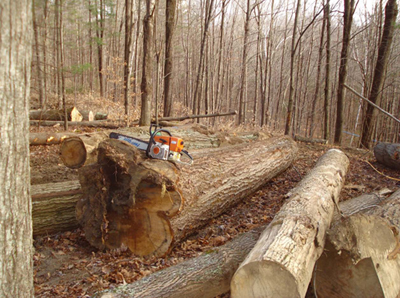
Peter Lammert
I’m hopeful that young folks will get information about the negatives of buying anything made out of medium-density fiberboard or flake board or particle board before they buy their first furniture. It absorbs water, then swells up and goes to pieces. Good, solid wood furniture costs more, but it will be passed down in the family and won’t end up on the side of the road with a sign that says “free” on it.
I’m hopeful that children will continue to learn that you have to thin a forest stand to grow large crop trees and that it takes 80 years to grow a mature softwood and 120 or more to grow a commercially mature hardwood.
I’m hopeful that I’ll soon see central, wood-fired heating in new inner-city housing and shopping complexes. If you don’t believe this works, don’t pay any attention to what’s going on in the Scandinavian countries.
Finally, I’m hopeful that our new governor will find the money and give it to a Maine company to design and produce a residential biomass burner for home heating. I want to install one of their first units.
Pete Lammert has been the Maine Forest Service’s utilization and marketing forester for 33 years.
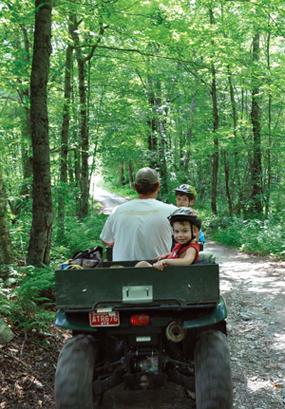
What our Readers Think
We asked the readers of our bi-weekly e-newsletter to tell us what made them hopeful. Here’s a sampling of what they had to share:
Now that we’ve stared down the barrel of a full-blown depression, there is an upside to a sputtering economic engine. How so? What’s good for the economy is not necessarily good for the environment. Reduced economic output also results in reduced greenhouse gas emissions, opportunities for forests to rejuvenate due to reduced demand on building materials, increased emphasis on a more local, natural food chain, and reduced commercial fishing that will allow wild stocks to recover. I don’t believe the economy has bottomed out, but when it does, we will still have our forests to support us.
James Patsakos, Ontario, Canada
What gives me hope as the seasons change and the challenges continue? Nature. Being aware of the life surrounding me helps me to keep the chaos in check. The awareness that this world belongs to something much greater than me is a comfort and a gift.
Sally Mullen, East Granby, CT
Dee-deeee….The spring song of the chickadee gives me perennial hope.
Carolyn Haley, East Wallingford, VT
There is wonder and amazement in my son’s eyes as he begins to see the world around him. I am eager to teach him about the natural environment, seasons, plants, and animals of this region. I am hopeful that his childhood will be full of learning about nature and that he will grow up to be respectful of our world.
Lissa Stark, Bennington, VT
I’ve been a bird hunter with an English springer spaniel for many years. One dog for 13 seasons, now I’m out with a younger dog. I cannot think of a day with either dog that was not hopeful. I have found a way to slip into the natural world that I think few people can understand without canine assistance. I have walked, hunted, and experienced in great detail the ecology of many places with not a word spoken all day, no e-mail sent, no papers or small talk. I have found where woodcock, grouse, and game birds live, but also the life-force of landscapes, their soils, water, plant life, and energy. The speed of a wagging tail, a pause here and there to locate a sign, a turn of a head and nose, encouragement with a wave is our shorthand. This communication over time becomes quite vivid, very direct and descriptive, yet there’s still plenty of mystery written between the lines.
Chris Hearn, Tiverton, RI
As president of a regional land trust in Massachusetts, I continue to be inspired and humbled by the generosity of landowners who, even in difficult financial times, choose to donate interests in real estate that in many cases has been in their family for generations. Leaving this kind of legacy for the benefit of all is, at its core, a very hopeful act.
Doug DeAngelis, Ipswich, MA
My husband and I inherited a 565-acre tree farm upon the death of both my parents, who themselves had inherited the same responsibility from my grandfather. Our hope is that we pass on our family’s long-held vision of stewardship to the next generation. This is the first year that our 29-year-old son has expressed a sincere desire to learn the many boundaries that contain this vast property. We have purposely included him in our consultations with our forester for the explicit purpose of fostering his knowledge and understanding of responsible forest management. He and his sisters are our hope that these beautiful woods entrusted to our care will thrive for many generations after we have left this world.
Laurie & Alan Hallquist, Winchendon, MA


